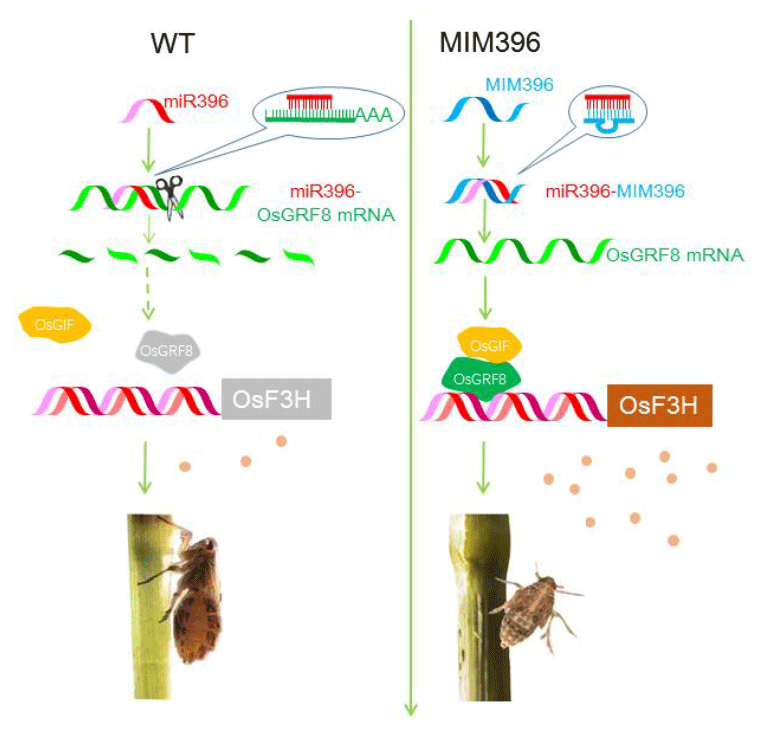博文
Plant Biotechnol J:水稻褐飞虱抗性新机制
||
The OsmiR396–OsGRF8–OsF3H‐flavonoid pathway mediates resistance to the brown planthopper in rice (Oryza sativa)
First author: Zhengyan Dai; Affiliations: Institute of Plant Physiology and Ecology, Chinese Academy of Sciences (中科院植物生理生态学研究所): Shanghai, China
Corresponding author: Zhenying Shi
Multi‐functional microRNAs (miRNAs) are emerging as key modulators of plant–pathogen interactions. Although the involvement of some miRNAs in plant–insect interactions has been revealed, the underlying mechanisms are still elusive. The brown planthopper (BPH) is the most notorious (臭名昭著的) rice (Oryza sativa)‐specific insect that causes severe yield losses each year and requires urgent biological control. To reveal the miRNAs involved in rice–BPH interactions, we performed miRNA sequencing and identified BPH‐ esponsive OsmiR396. Sequestering OsmiR396 by overexpressing target mimicry (MIM396) in three genetic backgrounds indicated that OsmiR396 negatively regulated BPH resistance. Over‐expression of one BPH‐ esponsive target gene of OsmiR396, growth regulating factor 8 (OsGRF8), showed resistance to BPH. Furthermore, the flavonoid contents increased in both the OsmiR396‐sequestered and the OsGRF8 over‐expressing plants. By analyzing 39 natural rice varieties, the elevated flavonoid contents were found to correlate with enhanced BPH resistance. Artificial applications of flavonoids to wild type (WT) plants also increased resistance to BPH. A BPH‐ esponsive flavanone 3‐hydroxylase (OsF3H) gene in the flavonoid biosynthetic pathway was proved to be directly regulated by OsGRF8. A genetic functional analysis of OsF3H revealed its positive role in mediating both the flavonoid contents and BPH resistance. And analysis of the genetic correlation between OsmiR396 and OsF3H showed that down‐ egulation of OsF3H complemented the BPH resistance characteristic and simultaneously decreased the flavonoid contents of the MIM396 plants. Thus, we revealed a new BPH resistance mechanism mediated by the OsmiR396–OsGRF8–OsF3H–flavonoid pathway. Our study suggests potential applications of miRNAs in BPH resistance breeding.
越来越多的研究显示具有多功能的miRNA是植物和病原菌互作的关键调节因子。尽管,已经有一些研究揭示了某些miRNA在植物与昆虫的互作中发挥作用,但具体的作用机理还有待探索。褐飞虱是最臭名昭著的的水稻特异性昆虫,导致每年严重的水稻产量损失,急需生物防控。为了研究miRNA在水稻与褐飞虱互作中的作用,作者进行了miRNA测序,鉴定到了水稻中响应褐飞虱的OsmiR396。在三个不同基因型的水稻中过表达MIM396来阻断OsmiR396的功能,结果显示OsmiR396负调控水稻的褐飞虱抗性。过表达OsmiR396其中一个褐飞虱响应靶基因OsGRF8,能够增强水稻对褐飞虱的抗性。此外,在过表达MIM396和过表达OsGRF8基因的水稻植株中,类黄酮化合物的含量均有所上升。通过分析39株水稻自然品种,作者发现水稻中类黄酮化合物含量的增加与褐飞虱抗性增强呈正比。对野生型水稻外施类黄酮化合物同样能够增强植株对于褐飞虱的抗性。类黄酮生物合成中OsF3H基因响应于褐飞虱,能够直接受到OsGRF8的调控。OsF3H的遗传学功能试验揭示了其正向调控植株的类黄酮含量和褐飞虱抗性。OsmiR396与OsF3H之间的遗传相关分析显示OsF3H的下调能够互补MIM396植株的褐飞虱抗性,同时降低植株中类黄酮含量。因此,本文的研究揭示了一个新的由OsmiR396–OsGRF8–OsF3H–类黄酮通路介导的褐飞虱抗性调控机制。本文的研究同时也揭示了miRNA应用于水稻褐飞虱抗性育种的潜力。
doi: https://doi.org/10.1111/pbi.13091
Journal: Plant Biotechnology Journal
First Published: February 07, 2019
https://blog.sciencenet.cn/blog-3158122-1161992.html
上一篇:Nature Plants:精细调控作物的水分利用效率及干旱抗性
下一篇:Communications Biology:陆地植物特有含DUF26结构域基因家族的演化分析
全部作者的其他最新博文
- • Plant Physiology:CsMADS3促进柑果中的叶绿素降解和类胡萝卜素合成(华中农业大学)
- • Molecular Plant:LBD11-ROS反馈调节作用于拟南芥的维管形成层增殖和次生生长(浦项科技大学)
- • Science Advances:根结线虫通过调控植物的CLE3-CLV1模块,促进侵染进程(日本熊本大学)
- • Nature Communications:油菜素内酯参与植物营养生长期转变的分子机制解析(浙江农林大学)
- • Current Biology:光合作用产生的蔗糖驱动侧根“生物钟”(德国弗莱堡大学)
- • PNAS:花同源异型基因在叶中被抑制、花中被激活的分子机制(南卡罗来纳大学)

